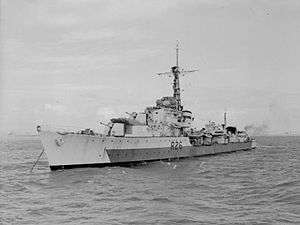HMS Comet (R26)
HMS Comet was one of thirty-two C-class destroyers built for the Royal Navy during the Second World War, a member of the eight-ship Co sub-class.
 Comet, 19 September 1945 | |
| History | |
|---|---|
| Name: | Comet |
| Builder: | Yarrow, Scotstoun |
| Laid down: | 14 June 1943 |
| Launched: | 22 June 1944 |
| Commissioned: | 6 June 1945 |
| Identification: | Pennant number: R26 (later D26) |
| Fate: | Arrived for breaking up at Troon on 23 June 1962 |
| General characteristics (as built) | |
| Class and type: | C-class destroyer |
| Displacement: | 1,865 long tons (1,895 t) (standard) |
| Length: | 362 ft 9 in (110.6 m) o/a |
| Beam: | 35 ft 8 in (10.9 m) |
| Draught: | 15 ft 3 in (4.6 m) (full load) |
| Installed power: | |
| Propulsion: | 2 shafts; 2 geared steam turbines |
| Speed: | 36 knots (67 km/h; 41 mph) |
| Range: | 4,675 nautical miles (8,658 km; 5,380 mi) at 20 knots (37 km/h; 23 mph) |
| Complement: | 186 |
| Armament: |
|
Design and description
The Co sub-class was a repeat of the preceding Ch sub-class. Comet displaced 1,865 long tons (1,895 t) at standard load and 2,515 long tons (2,555 t) at deep load. They had an overall length of 362 feet 9 inches (110.6 m), a beam of 35 feet 8 inches (10.9 m) and a deep draught of 15 feet 3 inches (4.6 m).[1]
The ships were powered by a pair of geared steam turbines, each driving one propeller shaft using steam provided by two Admiralty three-drum boilers. The turbines developed a total of 40,000 indicated horsepower (30,000 kW) and gave a speed of 36 knots (67 km/h; 41 mph) at normal load.[2] During her sea trials, Comet reached a speed of 31.8 knots (58.9 km/h; 36.6 mph) at a load of 2,200 long tons (2,200 t).[3] The Co sub-class carried enough fuel oil to give them a range of 4,675 nautical miles (8,658 km; 5,380 mi) at 20 knots (37 km/h; 23 mph). The ships' complement was 186 officers and ratings.[1]
The main armament of the destroyers consisted of four QF 4.5-inch (114 mm) Mk IV dual-purpose guns, one superfiring pair each fore and aft of the superstructure protected by partial gun shields. Their anti-aircraft suite consisted of one twin-gun stabilised Mk IV "Hazemeyer" mount for 40-millimetre (1.6 in) Bofors guns and two single 2-pounder (40 mm) AA guns amidships, and single mounts for a 20-millimetre (0.8 in) Oerlikon AA gun on the bridge wings.[1] The ships were fitted with one quadruple mount for 21-inch (533 mm) torpedo tubes.[4] The ships were equipped with a pair of depth charge rails and two throwers for 35 depth charges.[5]
Construction and career
Comet was ordered from Yarrow and the ship was laid down on 14 June 1943 at its shipyard in Scotstoun, launched on 22 June 1944 and was commissioned on 6 June 1945.[1]
On commissioning Comet served as part of the 8th Destroyer Squadron in the Far East. She returned to the UK for a refit in 1948. She was given an interim modernization and was fitted for minelaying.[6] The ship then served as part of the 6th Destroyer Squadron in the Home Fleet between 1953 and 1957. Comet was paid off in February 1958. Following her sale she arrived at the breakers yard for scrapping at Troon on 23 October 1962.[7]
References
- Lenton, p. 183
- Whitley, p. 136
- March, p. 429
- Chesneau, p. 43
- March, p. 424
- Marriott, pp. 65–66
- English, p. 137
Bibliography
- Chesneau, Roger, ed. (1980). Conway's All the World's Fighting Ships 1922–1946. Greenwich, UK: Conway Maritime Press. ISBN 0-85177-146-7.
- Colledge, J. J.; Warlow, Ben (2006) [1969]. Ships of the Royal Navy: The Complete Record of all Fighting Ships of the Royal Navy (Rev. ed.). London: Chatham Publishing. ISBN 978-1-86176-281-8.
- English, John (2001). Obdurate to Daring: British Fleet Destroyers 1941–45. Windsor, UK: World Ship Society. ISBN 978-0-9560769-0-8.
- Friedman, Norman (2006). British Destroyers and Frigates, the Second World War and After. Annapolis, Maryland: Naval Institute Press. ISBN 1-86176-137-6.
- Lenton, H. T. (1998). British & Empire Warships of the Second World War. Annapolis, Maryland: Naval Institute Press. ISBN 1-55750-048-7.
- March, Edgar J. (1966). British Destroyers: A History of Development, 1892–1953; Drawn by Admiralty Permission From Official Records & Returns, Ships' Covers & Building Plans. London: Seeley Service. OCLC 164893555.
- Marriott, Leo (1989). Royal Navy Destroyers Since 1945. Ian Allan. ISBN 0-7110-1817-0.
- Whitley, M. J. (1988). Destroyers of World War Two: An International Encyclopedia. Annapolis, Maryland: Naval Institute Press. ISBN 0-87021-326-1.